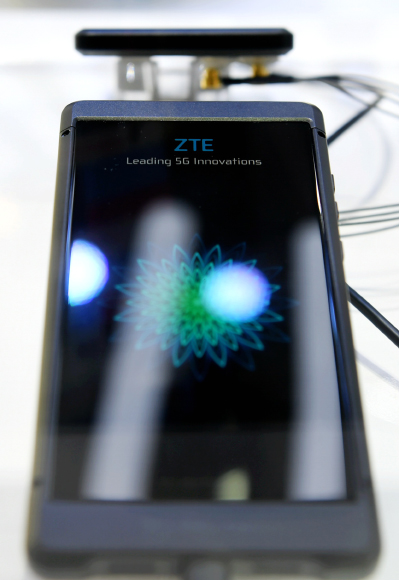| Business |
| Sending a New Signal | |
| As top foreign brands' innovation weakens, Chinese smartphones rise | |
|
|
 A woman makes a video conversation on her phone at the Chongqing North Railway Station on January 9, 2018 (XINHUA)
When Su Yiming and her seven former classmates had a reunion party at the end of 2018, it was Su's phone that became the center of attraction. When she took a photograph, the young women were blown away by the stunning features of the phone camera. Su, an office worker, also told them how her new Huawei phone scores over the latest iPhone model. It allows her to have two accounts on popular social media platform WeChat simultaneously, one for her personal use and one for her office use, a feature unavailable on the iPhone. Su also told them how she had to queue up for a long time when she bought the phone, reminiscent of the iPhone's launch of new models in the past. It testified to the Chinese phone maker's rising popularity at a time when many other brands have been suffering a bleak winter. Signs of change The year 2018 was significant for Chinese smartphone makers. According to the International Data Corp. (IDC), global smartphone shipments reached 355.2 million in the third quarter of 2018, down 6 percent year on year. It was the fourth consecutive quarter of decline. Chinese smartphone sales, too, dropped 10.2 percent, a slide that began from the second quarter of 2017 and has lasted for six consecutive quarters. Amid the downward trend globally, there have also been sea changes in the players' status and market share. An Hui, Director of the Institute of Electronic Information Industry at the China Center for Information Industry Development under the Ministry of Industry and Information Technology, told Beijing Review that the advantages of foreign giant phone manufacturers in innovation have significantly diminished. "Some Chinese brands are leading the way in many aspects," An said. "With increasing demand from domestic consumers, those brands, especially the prominent ones, are gaining competitiveness and market share." According to an IDC report, Huawei's smartphone shipments rose 13.4 percent year on year in the third quarter of 2018 and Vivo, another leading Chinese brand, reported an 18.5-percent increase in global shipments. Apple's market share in China showed a year-on-year decrease from 7.7 percent to 7.4 percent, relegating it to the fifth place following Huawei, Vivo, OPPO and Xiaomi. Another foreign giant, Samsung, lost its ascendancy a long time ago in the Chinese market and has begun adjusting its strategies by supplying phone components such as chips, screens and semiconductors. Su was among the first users of the iPhone 4 on the Chinese mainland in 2011. Later, she bought an iPhone 6. Then new brand Huawei replaced the iPhone as the former king lost its innovation attraction but still carried a high price tag, which put off buyers. "High quality used to be associated with high price," Su said. "But now, if we can buy similar qualities at a lower price, why not?" With Huawei and Vivo growing their market share and the other three among the top five fighting to regain theirs, small and medium-sized companies are being pushed out of competition. According to the IDC, the five companies accounted for 87.7 percent of the Chinese market in the third quarter of 2018, up 11.4 percent year on year, indicating that the pie is becoming smaller for other brands. As a result, it's inevitable that some will drop out of the fierce market competition. Gionee and Smartisan, which once made a splash with their sales, marketing and performance, faced a crisis in 2018 due to a crack in the capital chain and lack of innovation. This, in turn, has triggered a survival crisis for smartphone component suppliers as well, making them victims of the flagging market.
Vivo smartphones are displayed in the Luzhniki Stadium in Moscow as part of the Chinese company's sponsorship campaign for the FIFA World Cup tournament in Russia in 2018 (XINHUA)
Innovations needed "Without new demand, the smartphone market has come to aturning point," Huang Wei, Deputy Director of the Research Department of Integrated Circuits and Software, Institute of Integration of Informatization and Industrialization, China Academy of Information and Communications Technology, told Beijing Review. "China's smartphone market is becoming saturated as the smartphone penetration rate has reached 80 percent, which explains the weak sales." He said nowadays people change their phones after 22 months on average instead of 15 months, as they did several years ago. Improvement in quality and higher prices of smartphones have decelerated the purchasing frequency. A lack of phenomenal hardware innovations has also contributed to the failure to stimulate people's purchasing interest. When the shift from 2G to 3G wireless networks occurred, sales were triggered by hardware innovations and new mobile Internet technologies. The leap-frog developments made learning and traveling convenient with new software applications. But now, such momentous innovations have yet to happen. "The absence of disruptive innovations and pain-point functions (which help entrepreneurs to cash in on finding solutions to problems) is a great challenge for smartphone manufacturers," An said. "An insufficient grasp of core and key technologies is the other." Huang pointed out that the low innovation capacity of upstream companies in the industrial chain for developing memory chips and screen displays has constrained the profit margin and the companies' presence in the market. Also, identical smartphone designs and hardware components have lowered the differentiation degree. "Innovation has become a strategic terrain for manufacturers, which motivates technical and designing revolutions," Liu Zhao, a professor at the Intellectual Property (IP) Right School, University of the Chinese Academy of Sciences, told Beijing Review. Liu has an example. Apple's innovation capability was widely considered plateaued after the release of the iPhone X in 2017. This has created space for Chinese brands to overtake the U.S. giant. Besides, in the coming 5G wireless communication era, there will be more types of innovation, which will alter monopolies and optimize the IP structure in the market. China has made a shift from being a follower to the top runner in the 5G era. The coming years will see 5G deployment in China, which will facilitate a new round of innovation in the smartphone market.  A ZTE 5G mobile phone on display at the Mobile World Congress in Barcelona, Spain, on February 28, 2018 (XINHUA)
New 5G front Su said she is not going to change her phone this year and thinks her next smartphone will be a 5G one. The IDC predicted that 2019 will usher in the 5G era with many investment opportunities and market potentials. Global smartphone shipments are expected to end the slide and see a 2.6-percent increase year on year, showing stable growth. Shipments will bounce up again between 2020 and 2022. Although the pre-commercial trial of 5G starts in 2019, manufacturers have been racing ahead with attempts in different areas. Huawei has released its 5G memory chip, Vivo achieved 5G live streaming and Xiaomi completed its 5G network test in September 2018. According to An, it's crucial to accelerate the formulation of 5G standards and develop related products to pioneer in the mass production of 5G smartphones. Moreover, smartphone manufacturers should boost cooperation with software developers to promote integration between smartphones and applications to build and improve an ecological system featuring hardware plus software plus content plus services. Huang also regards expanded channels and markets as key factors. The past years have seen domestic brands' fast growth in small cities and towns across China. This market space will be a dominant factor to determine the future market situation. In addition, overseas markets, especially Southeast Asia, Latin America and Africa, are the smartphone industry's blue ocean and an important source of Chinese brands' market dividend. In response to the fierce competition in the Chinese market, several manufacturers have put their focus on overseas markets. TRANSSION Holdings' market share in Africa has reached 38 percent, surpassing Samsung's 23 percent. It is regarded as the top smartphone brand on the continent. Both Chinese small fries and giants such as Huawei and Xiaomi are expanding abroad. According to a report by Counterpoint Research released on December 31, 2018, in 2018, Xiaomi accounted for 27 percent of the total market share in India. Among the top 10 smartphone brands in India, nine are from China, indicating the great potential of Chinese smartphones in overseas markets, Huang added. Moreover, Huang said currently, Chinese brands are shedding their "low-end" and "cheap copy" labels, upgrading to high-end products, with some priced at more than 5,000 yuan ($729). According to Counterpoint's report, while the sales of smartphones decreased 5 percent in the third quarter of 2018, premium smartphone sales increased 19 percent. In the future, when international brands' competitiveness weakens, those who grab most market shares of premium smartphones will become the new leaders.
Copyedited by Sudeshna Sarkar Comments to zhangshsh@bjreview.com |
|
||||||||||||||||||||||||||||||
|
